After SVC's Annual TechCon there is always conversation about the most interesting presentation, the most forward-thinking products and services and, of course, the success of the TechCon as a whole. This year's event was one of the best ever, with an array of exceptional presentations and entire technical sessions capturing the attention of our attendees.
Consider SVConnections an outreach to our readership interested in continuing their 2011 TechCon experience. With a collection of recent technical and industry-related articles, you can stay in touch with the latest trends and discoveries in vacuum coating and related processes. |
| | |
|
Japan's Struggle Continues
From Chemical and Engineering News (C&EN) March 28, 2011, by Britt E. Erickson, et al. "The global electronics 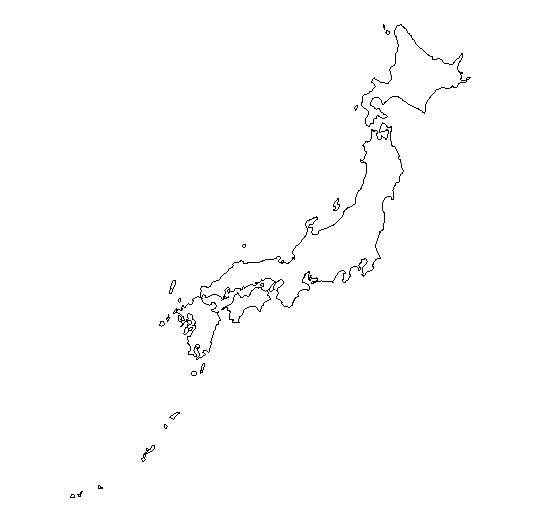
industry reported that it is facing serious shortages of key materials because of supply chain interruptions caused by the Japanese quake and tsunami. Out of commission are two facilities that together represent one-fourth of the world's capacity for silicon wafers, the base material for semiconductor fabrication. According to the Taipei-based market research firm DisplaySearch, indium tin oxide, a transparent conductor used in liquid-crystal displays, is made mostly in Japan. The world's largest producer, JX Nikko, has stopped production at a plant located 50 miles from the troubled Fukushima nuclear reactors."
Click here to read the full article at on the C&EN web site
|
|
|
|
Reverse Engineering of Multi-Layer Films
From Materials Today, March 2011, Volume 14, No.3, pp 114-117: Researchers at Agency for Science, Technology and Research (A*STAR), Singapore, report how Raman microscopy measurements and band-target entropy minimization (BTEM) can reverse-engineer the layers of a multi-layer packaging material without any a priori constituent information. This is a rapid and non-destructive approach. Multi-layer films are characterized often to examine the quality and composition of films in the interest of combining specific characteristics with other materials. Characterization is also conducted as verification of authenticity (i.e. counterfeit detection).
Source:
Materials Today: Click here to read the full article
|
| |
|
ASTM Introduces Corrosion Cost Tool, Updates Standard Coatings Terms
From PaintSquare.com, February 7, 2011:
"ASTM has developed its first standard for evaluating the lifecycle cost of corrosion protection systems and has revised its standard for coatings terms.
"ASTM A1068 - 10 Standard Practice for Life-Cycle Cost Analysis of Corrosion Protection Systems on Iron and Steel Products" covers a procedure for using life-cycle cost (LCC) analysis techniques to evaluate different corrosion protection system designs that satisfy the same functional requirements.
LCC analysis is a method for evaluating alternatives that involve different cash flows over the life of the designated project design.

The method involves calculating the LCC of each alternative capable of satisfying the project's functional requirement and comparing them to determine the lowest estimated LCC.
The technique measures the present value of all relevant costs of producing and rehabilitating alternative corrosion protection systems-including surface preparation, application, construction, rehabilitation or replacement-over a specified period of time."
Source:
Click on the link to read the entire article:
www.paintsquare.com: http://www.paintsquare.com/news/?fuseaction=view&id=5049
Image: ASTM International - Standards Worldwide |
|
|
|
Researchers Find Replacement for Rare Material Indium Tin Oxide
From Eurekalert.org, April 11, 2011: "Researchers at Eindhoven University of Technology (TU/e, Netherlands) have developed a replacement for indium tin oxide (ITO), an important material used in displays for all kinds of everyday products such as TVs, telephones and laptops, as well as in solar cells. Unfortunately indium is a rare metal, and the available supplies are expected to be virtually exhausted within as little as ten years. The replacement material is a transparent, conducting film produced in water, and based on electrically conducting carbon nanotubes and plastic nanoparticles. It is made of commonly available materials, and on top of that is also environment-friendly. The results, which also provide new insights into conduction in complex composite materials, were published online yesterday 10 April by the scientific journal Nature Nanotechnology.
 The research team has been able to achieve higher conductivity by combining low concentrations of carbon nanotubes and conducting latex in a low-cost polystyrene film. The nanotubes and the latex together account for less than 1 percent of the weight of the conducting film. That is important, because a high concentration of carbon nanotubes makes the film black and opaque, so the concentration needs to be kept as low as possible. The research team was led by theoretical physicist Paul van der Schoot and polymer chemist Cor Koning. Post-doc Andriy Kyrylyuk is the first author of the paper in Nature Nanotechnology." The research team has been able to achieve higher conductivity by combining low concentrations of carbon nanotubes and conducting latex in a low-cost polystyrene film. The nanotubes and the latex together account for less than 1 percent of the weight of the conducting film. That is important, because a high concentration of carbon nanotubes makes the film black and opaque, so the concentration needs to be kept as low as possible. The research team was led by theoretical physicist Paul van der Schoot and polymer chemist Cor Koning. Post-doc Andriy Kyrylyuk is the first author of the paper in Nature Nanotechnology."
Source:
www.eurekalert.org: http://www.eurekalert.org/pub_releases/2011-04/euot-rfr041111.php
Image: Bart van Overbeeke
|
| |
|
Researchers Develop Golden Window Electrodes for Organic Solar Cells
From University of Warwick News and Events, April 6, 2011: "Researchers at the University of Warwick have developed a gold plated window as the transparent electrode for organic solar cells. Contrary to what one might expect, these electrodes have the potential to be relatively cheap since the thickness of gold used is only 8 billionths of a metre. This ultra-low thickness means that even at the current high gold price the cost of the gold needed to fabricate one square metre of this electrode is only around £4.5. It can also be readily recouped from the organic solar cell at the end of its life and since gold is already widely used to form reliable interconnects it is no stranger to the electronics industry.
Organic solar cells have long relied on Indium Tin Oxide (ITO)
 coated glass as the transparent electrode, although this is largely due to the absence of a suitable alternative. ITO is a complex, unstable material with a high surface roughness and tendency to crack upon bending if supported on a plastic substrate. If that wasn't bad enough one of its key components, indium, is in short supply making it relatively expensive to use. coated glass as the transparent electrode, although this is largely due to the absence of a suitable alternative. ITO is a complex, unstable material with a high surface roughness and tendency to crack upon bending if supported on a plastic substrate. If that wasn't bad enough one of its key components, indium, is in short supply making it relatively expensive to use.
An ultra-thin film of air-stable metal like gold would offer a viable alternative to ITO, but until now it has not proved possible to deposit a film thin enough to be transparent without being too fragile and electrically resistive to be useful.
Now research led by Dr Ross Hatton and Professor Tim Jones in the University of Warwick 's department of Chemistry has developed a rapid method for the preparation of robust, ultra-thin gold films on glass. Importantly this method can be scaled up for large area applications like solar cells and the resulting electrodes are chemically very well-defined."
Source: Click on the link to read the entire article:
University of Warwick, Coventry United Kingdom:
http://www2.warwick.ac.uk/newsandevents/pressreleases/researchers_develop_golden/Image: University of Warwick
|
| |
|
AFM Improves Resolution of IR Spectroscopy
From Laser Focus World, March 2011, by Craig Prater, et al.: "A new technique, AFM-based infrared spectroscopy (AFM-IR) has emerged that successfully combines the nanoscale spatial resolution capabilities of AFM with IR spectroscopy. The result is an instrument that is able to measure and map local chemical composition below the diffraction limit, as well as perform nanoscale topographic, mechanical, and thermal analysis. Originally developed by Alexandre Dazzi and coworkers in France, the AFM-IR technique has recently been commercialized by Anasys Instruments. Named 'nanoIR', the instrument uses a pulsed, tunable IR laser source based on an optical parametric oscillator (OPO) to excite molecular vibrations in a sample that has been previously mounted to an IR transparent zinc selenide prism. The instrument can make detailed studies of the structural and chemical makeup of complex samples and can be applied to characterize polymer blends, multilayer films, coatings, and other materials."
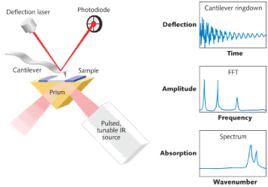
Source: Click the link to read the full article:
Laser Focus World, March 2011
|
| |
General Electric Commits $600M to Solar Ramp
From www.optics.org, April 7, 2011: "One of the biggest companies in the world is to invest $600 million to commercialize CdTe solar cells. General Electric (GE), which is more typically associated with conventional and nuclear energy technologies, has bought out PrimeStar Solar, and is planning to build a 400 MW manufacturing facility in the US.
The development should eventually provide some major competition for First Solar, rated as the world's third-largest solar cell manufacturer in 2010, and the market leader in thin-film CdTe technology by far.
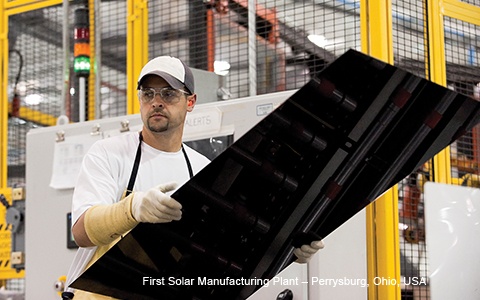 According to GE, PrimeStar - in which it has held a majority stake since 2008 - has already produced a thin-film CdTe panel with a conversion efficiency of 12.8%, as verified by the US National Renewable Energy Laboratory (NREL). Although that is only a single result at this point, the figure compares extremely well with First Solar's average module efficiency of 11.6% - although First has previously said that it expects to improve that figure by about 0.5% per year. According to GE, PrimeStar - in which it has held a majority stake since 2008 - has already produced a thin-film CdTe panel with a conversion efficiency of 12.8%, as verified by the US National Renewable Energy Laboratory (NREL). Although that is only a single result at this point, the figure compares extremely well with First Solar's average module efficiency of 11.6% - although First has previously said that it expects to improve that figure by about 0.5% per year.
"Photovoltaic solar is the next step in growing GE's renewable energy portfolio and is part of the company's 'ecomagination' commitment to drive clean energy technology through innovation and R&D investment," said the company, which has also been developing solid-state lighting products under the ecomagination umbrella."
Source: Click the link to read the full article:
www.optics.org: http://optics.org/news/2/4/11
Image: First Solar
|
| |
|
Solar Power Goes Viral
From MIT News, April 25, 2011, by David L. Chandler: "Researchers at MIT have found a way to make significant improvements to the power-conversion efficiency of solar cells by enlisting the services of tiny viruses to perform detailed assembly work at the microscopic level.
In a solar cell, sunlight hits a light-harvesting material, causing it to release electrons that can be harnessed to produce an electric current. The new MIT research, published online this week in the journal Nature Nanotechnology, is based on findings that carbon nanotubes - microscopic, hollow cylinders of pure carbon - can enhance the efficiency of electron collection from a solar cell's surface.
Previous attempts to use the nanotubes, however, had been thwarted by two problems. First, the making of carbon nanotubes generally produces a mix of two types, some of which act as semiconductors (sometimes allowing an electric current to flow, sometimes not) or metals (which act like wires, allowing current to flow easily). The new research, for the first time, showed that the effects of these two types tend to be different, because the semiconducting nanotubes can enhance the performance of solar cells, but the metallic ones have the opposite effect. Second, nanotubes tend to clump together, which reduces their effectiveness.
And that's where viruses come to the rescue. Graduate students Xiangnan Dang and Hyunjung Yi - working with Angela Belcher, the W. M. Keck Professor of Energy, and several other researchers - found that a genetically engineered version of a virus called M13, which normally infects bacteria, can be used to control the arrangement of the nanotubes on a surface, keeping the tubes separate so they can't short out the circuits, and keeping the tubes apart so they don't clump."

Source: Click the link to read the full article:
MIT News:
http://web.mit.edu/newsoffice/2011/solar-virus-0425.html
Image: Matt Klug, Biomolecular Materials Group
|
| |
|
LED Shipments to Increase Over 40% in 2011
From AZOoptics.com, April 21, 2011, by Andy Choi: "The Information Network, a market research firm based in New Tripoli, (PA) has released a new market research report titled 'The Solid State Lighting Revolution: Market Analysis And Insight On Reducing Manufacturing Costs.'
According to the report, the unit shipments of LEDs are anticipated to increase over 40% in 2011 and twofold between the period of 2010 to 2013. The unit shipments of high brightness LEDs is expected to reach about 135 billion units in 2011 when compared to less than 100 billion units in 2010, while the backlight LEDs will reach 30 billion units, compared to 20 billion in 2011.
As per the report, Nichia was the top player with a 15% market share in 2010 followed by Samsung LED with a 10.5% share. In 2010, Aixtron was the top player in the MOCVD tool market with over 55% share, while Veeco retained the second position with a 41% market share.
The President at The Information Network, Robert Castellano said that China accounted for about 35% share of MOCVD deployments in 2010.
Source: Click on the link to read the entire article:
AZOoptics.com:
http://www.azooptics.com/Details.asp?newsID=13616The report is available for purchase from The Information Network: http://www.theinformationnet.com/led.html
|
| | |
|
Smart Polymer Coatings with Plasma Polymerization
From Materials Views, April 6, 2011, by Carmen Teutsch: "'Biofouling' is the unwanted adhesion and growth of bio-molecules, such as proteins and micro-organisms, on the surfaces of biomedical and marine devices and tools that poses an adverse effect on the performance and efficiency of the devices. Therefore, development of anti-biofouling surfaces has great technological as well as industrial importance."
"Professor F. Arefi-Khonsari's research group at ENSCP, UPMC, Paris, has expertise in development of different plasma reactors (low pressure as well as atmospheric pressure systems) for the surface treatment of polymers and plasma deposition of organic or inorganic thin films and to understand the plasma-surface interactions by coupling plasma and surface diagnostic techniques. Recently, Prof. Arefi's group has explored a rather new field, namely plasma copolymerization in low pressure plasma systems for a wide range of applications."
Source:
Materials Views: http://www.materialsviews.com/details/news/1038511/Smart_Polymer_Coatings_with_Plasma_Polymerization.html
|
|
|
|
Thin Sheet of Diamond Has World of Uses
From Lab Manager Magazine, April 5, 2011, by Jared Sagoff: "Even as royalty set diamonds into crowns and rings, engineers lusted after the gems for different reasons: diamonds are stronger than any other natural material and are excellent electrical insulators and heat conductors. Today they are widely used in industry and factories. But the diamond supply is limited, and while artificial diamonds can be made in gem form, they have been hard to synthesize in thin films.
A new technique invented at Argonne National Laboratory creates thin films of diamond with grains so small they're called ultrananocrystalline diamond films. The films can be applied to an astounding array of surfaces and uses, ranging from better seals on pumps to heart pump walls so smooth that dangerous blood clots don't form. The grains of diamond in the film are just five nanometers across-about a billion of them would fit inside one red blood cell.
The innovation sprang from DOE Office of Science-funded research, when materials scientists Dieter Gruen, Alan Krauss, Orlando Auciello, and John Carlisle developed a gas-based method to form the diamond films to precise standards."
Source:
Lab Manager Magazine: http://www.labmanager.com/?articles.view/articleNo/4533/article/Thin-Sheet-of-Diamond-Has-Worlds-of-Uses
|
|
|
Do You Have an Interesting Article to Share?

Interested in sharing the latest news in vacuum coating technology? Forward us a link to an article you want to share with the rest of the SVC readership to publications@svc.org. Purchase advertising space in this newsletterby contacting SVC at svcinfo@svc.org.
Society of Vacuum Coaters
71 Pinon Hill Place NE
Albuquerque, New Mexico 87122
505-856-7188
|
| |
|

Speed pump-down and vacuum performance with RediVac™ Vented Screws and Vacuum Baked O-Rings from UC Components Inc. www.uccomponents.com |
| |
|

Veeco provides RF Linear Ion Sources for medium and large scale substrates featuring a broad power range and patented technology that provides reliability and performance.
To Learn More Visit:
www.veeco.com
970-221-1807
|
| |
|

Solid Sealing Technology designs and manufactures hermetic assemblies using metalizing, brazing and glass-ceramic sealing including standard and custom Feedthroughs/Connectors for extreme environments and UHV.
Contact:
Ph: 518-874-3600
Fax: 518-874-3610 info@solidsealing.com
|
| |
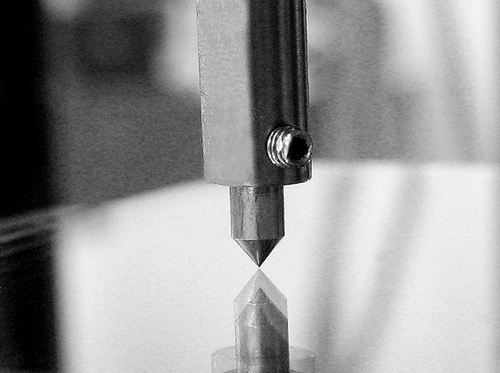
Nanovea manufactures Profilometers, Mechanical Testers & Tribometers to combine the most advanced testing capabilities in the industry. And unlike other manufacturers, Nanovea also provides Laboratory Services.
Learn More
www.nanovea.com
E-Mail: info@nanovea.com
Phone: 949-461-9292 |
| |
|
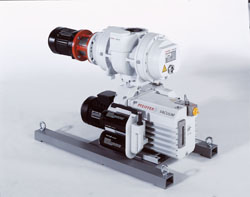
Roots Pumping Stations
Pfeiffer Vacuum CombiLine™ Roots Pumping Stations optimize industrial coating processes in pressure ranges from atmosphere to high vacuum. They include all pumps, gauges, analytical equipment and control systems.
Learn More.
Pfeiffer Vacuum, Inc.
24 Trafalgar Square
Nashua, NH 03063-1988
Phone: 603-578-6500
combiline@pfeiffer-vacuum.com
|
| |
BellowsTech stainless steel bellows are manufactured using edge welded technology for UHV applications. AM350, 304L, and 316L stainless steels are standard options with over eighty standard diaphragm sizes. Learn More.
BellowsTech, LLC
Phone: 386-615-7530
www.bellowstech.com
Email: bellows@bellowstech.com
|
| |
SIMS Workstation
A high performance SIMS instrument for:
- Thin film depth profiling
- Surface imaging
- Features new high sensitivity sputtered neutrals detection mode for quantitative analysis
Learn More
E-mail address: info@hiden.co.uk Phone: +44 [0] 1925 445225 (UK) or [1] 734 542 6666 (USA) Website: www.HidenAnalytical.com
|
| |
VAT manufactures high quality vacuum valves for a variety of applications. Products include: gate, angle, fast-closing, transfer, pendulum, throttle, pressure control, all-metal and customized valves. Learn more.
Contact Us:
Phone: 781-935-1446
or 800-935-1446
E-Mail: US@vatvalve.com
|
| |

Dual Stage Rotary Vane Pumps
The VD Series dual stage, oil rotary vacuum pumps are available in pumping speeds from 600 - 800 l/min. They're lightweight and feature low noise with minimal vibration levels.
Learn More.
ULVAC Technologies, Inc.
Visit Us Online
Tel: 1-978-686-7550
E-mail: sales@us.ulvac.com
|
| |
INFICON thin film deposition controllers, monitors and accessories, including customizable sensors and feedthroughs, offer features, function and value targeted to your application. View our catalog and contact us today!
INFICON
www.inficon.com
E-mail: reachus@inficon.com
|
| |
Rotary Motion Feedthroughs
Rigaku offers a full range of feedthroughs, including low cost SuperseaL, hollow shaft, solid shaft, motorized, UHV, custom designs and competitive direct replacements.
Learn More.
Rigaku Vacuum Products www.rigakuvacuum.com
E-mail: vacuum-info@rigaku.com
Phone: 603-890-6001
|
| |
Power Your Electrostatic Chucks with Comdel
With more than 30 models from 1 to 10 kV, Comdel has the ESC power supply that's right for your application.
Learn more.
Comdel
11 Kondelin Road
Gloucester, MA 01930
Tel: 978-282-0620 or 800-468-3144
Fax: 978-282-4980
www.comdel.com
info@comdel.com
|
| |
|
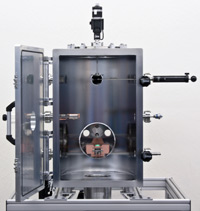
MDC's Bundled Engineered Solutions
MDC offers virtually every component required for vacuum coating applications. With MDC's standard chamber line you have the advantage of bundling these high quality pieces together without hours or weeks of special engineering. More...
MDC
engineered process solutions
www.mdcvacuum.com
|
| |
|

Choose Evatec's MSP sputter tool for high volume production in 3D technology and enjoy excellent thin film repeatabilities, a proven tool concept and a reliable partner. Contact Evatec's dedicated USA office for all your local sales and service requirements in thin film technology.
Phone: (603) 669-9656 www.evatecnet.com E-Mail: infoNA@evatecnet.com
|
| |
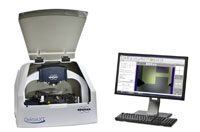
Bruker's DektakXT™Stylus Profiler Setting a new standard in high- performance thin-film measurements with better than 5Å step height repeatability, 40% faster scanning, and a single-arch design, improving the system's noise floor. Learn More. Bruker Corporation 520-741-1044 productinfo@bruker-nano.com |
| |
|
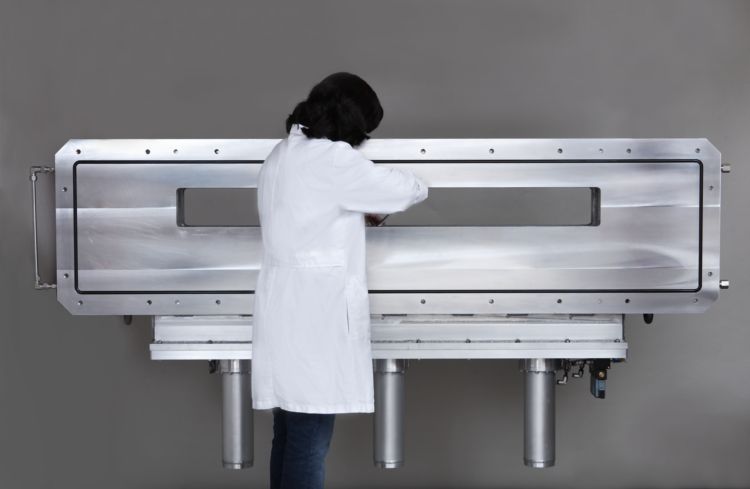
Rectangular Port Vacuum Valves
Ports to 220 X 1400 mm; 8 X 55 inch. Aluminum, Steel, or Stainless Steel. (RoHS) 2002/95/EC Compliant. Auto Close or Open on Power Fail. NW and ISO Gauge & Roughing Ports.
Vacuum Research Corporation Phone:800/426-9340
Web: www.vacuumresearch.com
E-Mail: vrc@vacuumresearch.com
|
| |

Dynavac's Odyssey 450 Deposition System is a small-scale tool providing an affordable, turnkey solution for uniform deposition of many materials. Its flexible architecture supports multiple upgrades and processes, including sputtering, evaporation, and ion assist. With its compact footprint, it is ideal for process development, pilot production, and research laboratories in both industry and universities.
www.dynavac.com
Telephone: 781-740-8600
E-Mail: sales@dynavac.com |
| |
SVC On-Location
Education Program

Bring High Quality, Practical Tutorials in PVD Processing and Vacuum Technology to Your Facility.
SVC Provides:
Recognized Instructors
Practical Information
A Schedule Convenient for You
Cost-Effective Training
Learn More...
|
| |
Save the Dates!
The 55th Annual SVC TechCon
April 28 - May 3, 2012
Santa Clara, California

|
| |
|